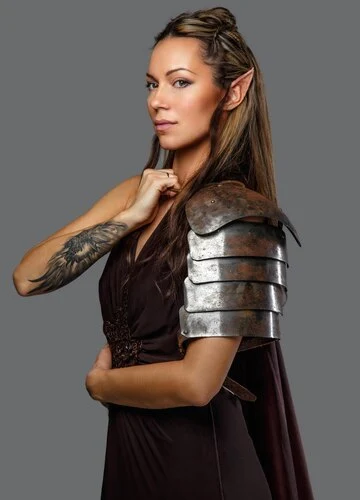Viking Women Hair: Unveiling the Beauty and Practicality
Viking women were as remarkable as their male counterparts. Strong, independent, and often contributing to daily life beyond the hearth, their hairstyles reflected not just beauty but also social status and practicality. While there’s no single “Viking hairstyle,” archaeological evidence and artistic depictions paint a fascinating picture of how Viking women wore their hair.
This blog post, Viking Women Hair, delves into the world of Viking women’s hairstyles, exploring their functionality, symbolism, and the various styles documented throughout the Viking Age.
Beyond Rapunzel: Practical Considerations
Unlike the flowing locks often associated with fairytales, Viking women’s hair was most likely kept at a practical length – typically reaching the shoulders or mid-back. This practicality stemmed from their active lives.
Long hair, if not secured, could be a hindrance during daily chores, sailing, or even combat. Viking women were not just homemakers; many participated in trade, crafts, and even warfare. Keeping their hair manageable was essential.
Braiding: A Hallmark of Viking Hair
Braids were a defining characteristic of Viking hairstyles for both men and women. They offered a secure and stylish way to keep hair out of the face and neck. Viking women likely used a variety of braiding techniques, from simple two-strand braids to more intricate styles like the five- or six-strand braids sometimes depicted on figurines.
These braids could be left loose, adorned with beads or feathers, or incorporated into more elaborate updos.
The Jelling Style: Status Symbol or Practical Updo?
One of the most recognizable Viking hairstyles is the Jelling style, named after the Jelling stone in Denmark, which depicts a woman with an elaborate braided topknot. This style involved braiding the hair and wrapping it around the head to create a bun.
While some believe the Jelling style was solely a symbol of high social status, it’s also possible that it served a practical purpose. By gathering the hair on top of the head, it would have been even more secure and kept cool during warmer weather.
Hairstyles for Every Occasion
Viking women likely adapted their hairstyles depending on the occasion. Here are some potential variations:
- Everyday wear: Simple braids or buns were likely the norm for daily activities.
- Formal occasions: Updos like the Jelling style or intricate braided patterns might have been worn for weddings or important gatherings.
- Travel and Work: Loose braids or ponytails with secure fastenings would have been ideal for keeping hair out of the way during travel or labor-intensive tasks.
- Unmarried women: Some evidence suggests unmarried women might have worn their hair loose or in a single braid down the back.
Beyond the Archaeological Evidence: Artistic Depictions
While archaeological finds like combs and hairpins offer clues about Viking hairstyles, artistic depictions from the era also provide valuable insights. These depictions, however, should be viewed with some caution.
Carvings on stones and metalwork often used simplified styles for visual clarity. Additionally, these depictions might have focused on the hairstyles of the elite, not necessarily reflecting the everyday styles of the average Viking woman.
Unveiling the Tools of the Trade
Viking women likely didn’t have access to the vast array of hair styling tools we have today. However, archaeological finds reveal a range of implements that would have been crucial for creating and maintaining their hairstyles:
- Combs: Made from bone, antler, or wood, combs were essential for detangling and styling hair.
- Hairpins: These were used to secure braids and updos. Bone, wood, and even bronze hairpins have been found in Viking Age excavations.
- Beads and Feathers: These decorative elements were not just for aesthetics; they could also help secure braids and add a touch of personality.
A Legacy of Strength and Style
Viking women’s hairstyles were more than just a way to look good. They were a reflection of their social status, their roles within society, and their practical needs.
By understanding these hairstyles, we gain a deeper appreciation for the lives and ingenuity of Viking women. Whether it was a simple braid for daily chores or an elaborate Jelling style for a special occasion, Viking women’s hair played a significant role in their world.
Viking Women Hair as a Resource
This blog post, Viking Women Hair, aims to be a valuable resource for anyone interested in learning more about this fascinating topic. We encourage you to explore further by:
- Visiting museums with Viking Age artifacts, where you might see combs, hairpins, and even depictions of hairstyles.
- Researching online resources that offer deeper dives into specific Viking hairstyles and braiding techniques.
- Experimenting with recreating Viking hairstyles yourself – there are many tutorials available online!
Viking Hair Inspiration: Bringing the Past to the Present
Viking hairstyles offer a wealth of inspiration for those interested in recreating historical styles or simply adding a touch of Viking flair to their everyday look. Here, Viking Women Hair explores some ways to incorporate these elements into your own hairstyling:
Modern Adaptations:
-
Braided Beauty: Braids are a timeless classic, and Viking-inspired braids can be surprisingly versatile. Try a simple two-strand braid or experiment with more intricate styles like a four-strand braid or a French braid. You can incorporate braids into updos, half-up, half-down hairstyles, or even add them to ponytails for a unique twist.
-
Updos with a Twist: The Jelling style might seem elaborate, but there are ways to achieve a similar look with a modern twist. Try a braided bun by incorporating a braid into your usual messy bun style. Experiment with different braiding techniques and placements for a personalized touch.
-
Accessorize Like a Viking: Hair accessories were an important part of Viking hairstyles. Look for hairpins made from natural materials like wood or bone, or incorporate decorative beads or feathers into your braids for an authentic touch.
-
Embrace the Headband: Headbands were a common accessory for Viking women, especially unmarried women. Modern headbands offer a stylish way to incorporate this element. Look for headbands with woven details or metallic accents for a touch of Viking inspiration.
Remember: When recreating Viking hairstyles, it’s important to prioritize hair health. Avoid tight braiding styles that can cause damage and use hair-friendly products to keep your hair nourished.
Beyond Hairstyles: Viking Hair Inspiration in Fashion and Beyond
The influence of Viking aesthetics extends beyond hairstyles. Here are some ways to incorporate Viking inspiration into your overall look:
- Jewelry: Viking jewelry was often bold and symbolic. Look for statement necklaces, chunky bracelets, or pieces featuring runes or Norse mythology motifs.
- Clothing: Natural fabrics like linen and wool were common Viking materials. Consider incorporating these textures into your wardrobe or look for clothing with Viking-inspired details like embroidery or leather accents.
- Makeup: While there’s limited information on Viking makeup practices, some evidence suggests they used kohl for eyeliner. A subtle smoky eye or a touch of kohl can add a touch of Viking drama to your makeup routine.
Ultimately, Viking women’s hair is a testament to their practicality, resourcefulness, and sense of style. By understanding their hairstyles and incorporating elements into your own look, you can celebrate the enduring legacy of these remarkable women.
We hope Viking Women Hair has served as a valuable resource for your exploration of Viking hairstyles. With a little creativity and inspiration from the past, you can create a unique and stylish look that reflects the spirit of the Viking Age.




